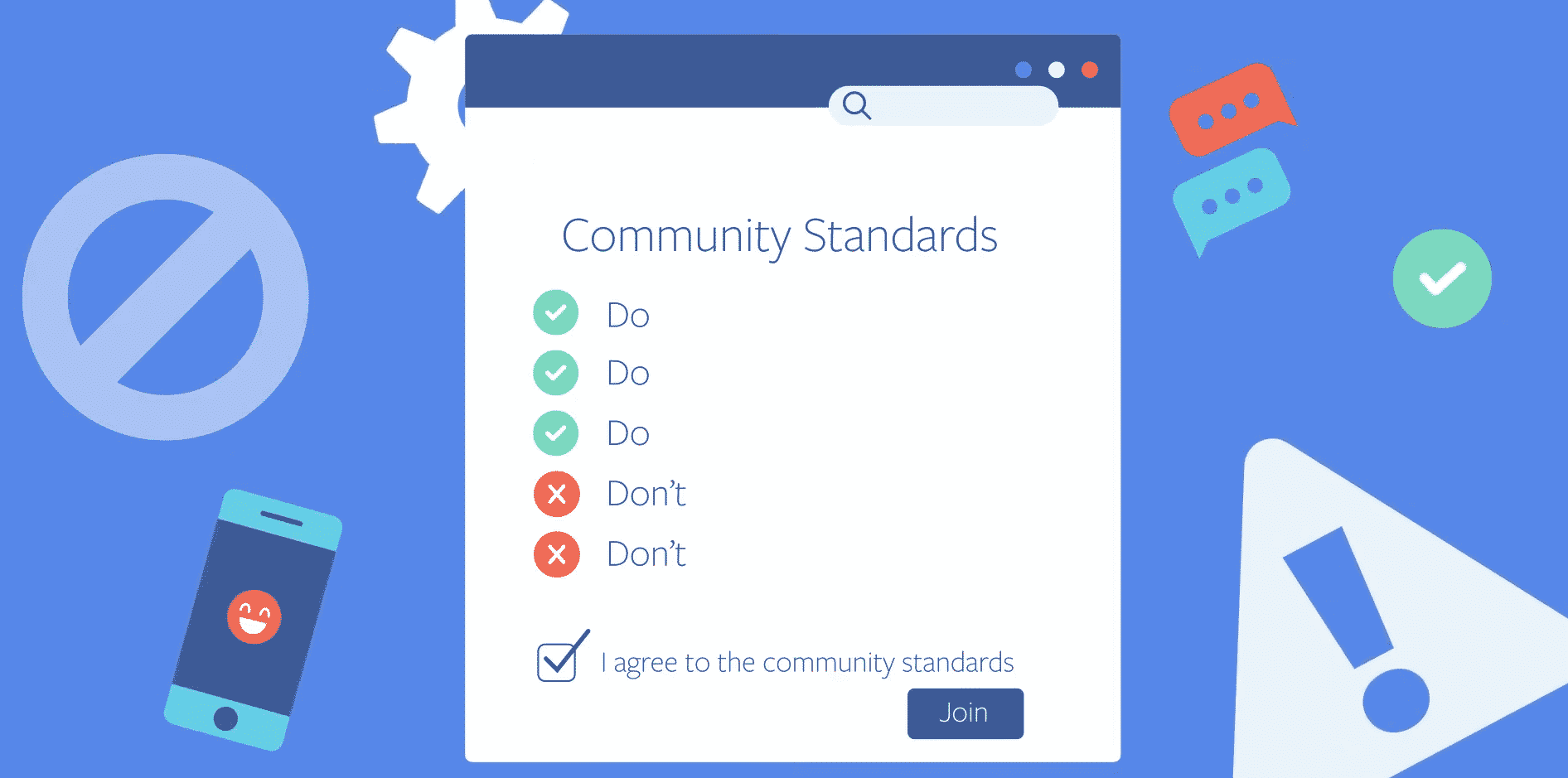Knowing how to build an online community and engage with your customers online, and allow a forum for them to connect and engage with each other is essential for any organization.
In fact, successful communities have been proven to be one of the best investments you can make, generating an ROI of almost 6,500% on average! Mind-blowing figures right?
In this article, we will explore how you can build a community online, based on a set of rules created by social media platforms that ensure a certain standard of conduct.
Here are 8 SECRET tips you should know when creating your organization’s community guidelines and learning how to build a community online.
Table of Contents
What Is An Online Community?
Online communities are groups of people united by common interests, opinions and goals who meet in an online space.
Depending on your business objectives, this could be a private group for sharing learnings and transformation stories. It may look like an open community where thousands of people come together to share resources and feedback. For example, members of the fitness community can share their social channels and journey to connect with real people and form authentic connections.
- learn and collaborate on businesses/projects
Secrets To Building Your Online Community
1. Define Clear Objectives
Start by clearly defining the purpose of your online community. Are you looking to provide customer support, build brand awareness, create a knowledge-sharing hub, or foster a social group around shared interests?
Your objectives will shape the community’s structure, tone, and content. Set measurable goals, such as increasing user engagement, fostering brand loyalty, or generating user-generated content.
These goals should align with your overall business strategy and be revisited periodically to ensure they remain relevant as the community evolves.
2. Choose The Right Platform
Selecting the appropriate platform is crucial for the success of your community. Consider factors like ease of use, customization options, and integration with existing tools and systems.
Platforms like Facebook Groups, Slack, Discord, or dedicated forums each offer different features that can cater to various community needs. For instance, a platform with robust discussion capabilities and media-sharing options may be ideal for a support community, while a simple, text-based forum might suffice for knowledge-sharing.
Evaluate the scalability of the platform to accommodate future growth and ensure it aligns with your community’s goals and user preferences.
3. Create Community Guidelines
After deciding on the type of community, you should also decide on the guidelines to be implemented. Guidelines exist to ensure quality content and enforce a standard of behavior for users to interact within a safe online environment.
The best place to start your community guidelines is a mission statement.
A mission statement is a formal summary that outlines the general purpose of your community and the business goals you want to achieve with it. What do you hope to accomplish with this community? How does it help reinforce your brand’s values?
Next, keep your average community member in mind and avoid filling your community guidelines with ‘legalese’ or industry jargon. The most important thing to consider is that you want your members and participants to read your guidelines, so they should be concise and easy to digest.
Avoiding ambiguity is crucial when stating your community guidelines. Don’t just say: “Comments should not be rude or derogatory”, as that can be open to subjective interpretation. Better to give examples of the kind of comments that won’t be tolerated, such as: “Comments that degrade on the basis of race, religion, gender, age, or abilities are not acceptable. Such comments will be moderated and possibly deleted.”
Regardless of the type of community, you’re aiming for, there should be some rules regarding the following fundamental areas:
- Personal Safety: Harassment, hate speech, bullying, discrimination, sexual exploitation, self-harm, privacy violations, and doxing.
- Illegal activity: Scams, fraud, drugs, and other controlled substances, promoting crime or violent organizations.
- Integrity: Spam, account verification and multiple account users, disinformation, and fake news.
- Protection of intellectual property: Of both the site and other users

4. Foster Engagement
Active engagement is the lifeblood of any online community. Regularly update the community with relevant content, such as articles, videos, or announcements. Encourage members to participate in discussions, share their experiences, and contribute content.
Interactive activities like polls, challenges, and events can boost participation and make members feel more connected. Recognize and celebrate active members to motivate others. The key is to create a dynamic environment where members feel valued and excited to return.
5. Moderate Effectively
Effective moderation is crucial for maintaining the community’s health and ensuring adherence to the guidelines. Moderators should be trained to handle conflicts, enforce rules, and foster constructive dialogue.
Moderation tools, such as automated filters and reporting systems, manage inappropriate content and play a vital role in welcoming new members, addressing concerns, and keeping discussions on track.
The goal is to create a balanced approach that allows for open expression while maintaining a respectful and safe environment.
6. Leverage Content And Resources
Offering valuable content and resources can significantly enhance the community experience. Provide members with exclusive content, such as expert insights, tutorials, webinars, and downloadable materials.
These resources should align with the community’s interests and goals, providing real value that keeps members engaged. Collaborate with industry experts or influencers to offer unique perspectives and elevate the content quality.
Additionally, consider creating a content calendar to ensure consistent updates and maintain member interest.
7. Promote Inclusivity
An inclusive community welcomes diverse perspectives and ensures that all members feel valued and respected. Foster discussions around different viewpoints and experiences to encourage open-mindedness and understanding.
Be proactive in addressing any discriminatory behavior or bias. Inclusivity also means being accessible; consider the needs of all members, including those with disabilities, and ensure your platform and content are accessible to everyone.
Creating an inclusive environment not only enriches the community’s culture but also broadens its appeal.
8. Gather Feedback And Adapt
Continuously seeking feedback from members is vital for the community’s growth and improvement. Use surveys, polls, and direct conversations to understand their needs, preferences, and pain points. This feedback can guide changes in content, features, and moderation policies.
Be open to evolving the community structure and rules to adapt to changing trends and member expectations. Regularly communicate updates and changes to the community, showing that their input is valued and acted upon.
This iterative approach helps in building a responsive and member-centric community.
Benefits Of Building An Online Community
Establishing an online community offers businesses a range of benefits that extend beyond traditional customer interactions. By creating community guidelines and providing a structured environment, companies can foster meaningful connections with their audience. Here are some key advantages:
- Direct Communication & Engagement: Building an online community provides a platform for direct interaction with customers, allowing brands to gather valuable insights into their preferences and needs. This engagement helps businesses better understand their market and tailor their offerings accordingly, enhancing overall customer satisfaction.
- Valuable Product Feedback: An online community is an excellent venue for receiving candid feedback and suggestions from members. This input is invaluable for refining products and services, ensuring they meet customer expectations. Additionally, creating community guidelines helps maintain a respectful and constructive environment for sharing ideas.
- Increased Customer Loyalty & Retention: A well-managed online community fosters a sense of belonging among its members, which can lead to increased customer loyalty. When customers feel connected to a community and brand, they are more likely to continue their engagement, advocate for the brand, and make repeat purchases, thereby improving customer retention.
- Peer-to-Peer Support: Online communities often become spaces where members support one another by sharing experiences, advice, and solutions. This peer-to-peer interaction not only alleviates pressure on customer service teams but also strengthens the community by building trust and camaraderie among members.
- Exclusive Content & Events: Offering exclusive content, such as webinars, tutorials, and special discounts, can attract new members and provide added value to existing ones. This strategy not only enhances the community experience but also reinforces the brand’s commitment to its members, making the community a valuable resource.
Best Practices For A Successful Online Community
Building a successful online community requires careful planning and execution. Here are some best practices to consider when you build online communities:
- Define Clear Objectives: Establish specific goals and objectives for your community. Whether you’re looking to increase brand awareness, provide customer support, or foster a space for shared interests, having a clear purpose will guide your community’s growth and direction.
- Create and Enforce Community Guidelines: Establishing rules is crucial for maintaining a respectful and constructive environment. Community guidelines should outline acceptable behavior, define the types of content allowed, and provide protocols for conflict resolution. This framework helps manage expectations and ensures a positive experience for all members.
- Foster Engagement and Interaction: Encourage active participation by regularly posting engaging content, such as discussion topics, polls, and events. Building a thriving online community depends on creating opportunities for members to connect, share insights, and collaborate.
- Consistent Moderation: Effective moderation is key to maintaining a healthy community atmosphere. Moderators should be trained to handle disputes, enforce rules, and promote constructive dialogue. This helps in keeping the community safe and welcoming.
- Leverage Member Contributions: Highlight and celebrate contributions from community members. Recognizing and rewarding active participants can foster a sense of ownership and belonging, motivating others to engage more actively.
- Provide Value: Regularly offer valuable content and resources, such as expert insights, tutorials, or exclusive access to events. This not only attracts new members but also retains existing ones by continuously delivering benefits that align with their interests
Types Of Online Communities
When you create an online community, understanding the various types can help you design and manage the space effectively. Each type serves different purposes and caters to specific audiences. Here are some common types of online communities:
- Interest-Based Communities: These communities are formed around shared hobbies, passions, or interests. Members engage in discussions, share tips, and collaborate on projects related to their common interests. For instance, forums for photography enthusiasts or groups for book lovers fall under this category.
- Support Communities: Support communities provide a space for individuals to seek advice, share experiences, and offer support on specific issues. These can range from health-related communities to those focused on personal development or mental health. Creating community guidelines is crucial here to ensure a safe and supportive environment for all members.
- Customer or Brand Communities: Brands create these communities to connect with their customers, offer support, and build loyalty. They often feature product discussions, feedback opportunities, and exclusive offers. Such communities help brands gather valuable insights and foster strong relationships with their customer base.
- Learning Communities: Focused on education and skill development, learning communities bring together individuals who want to learn and grow. They often include online courses, webinars, and discussions on various topics. These communities provide a platform for members to ask questions, share knowledge, and collaborate on learning activities.
- Professional Communities: Professional communities are designed for networking and career development. They provide a platform for professionals to connect, share industry insights, and find job opportunities. These communities often host discussions on industry trends, offer mentoring, and organize events.
- Action Communities: These communities rally around a cause or a specific mission. Members work together to drive social change, organize events, and advocate for issues they care about. Clear community guidelines are essential to align members with the group’s mission and ensure productive discussions.
Conclusion On How To Build A Community Online (With Gear Inc)
Building a thriving online community requires a thoughtful approach that balances engagement, clear guidelines, and reliable support. At Gear Inc, we specialize in helping businesses create vibrant online spaces through our comprehensive content moderation and live chat support services. Our expertise ensures that your community remains respectful, engaging, and aligned with your brand’s values.
Whether you’re just starting or looking to enhance your existing community, Gear Inc is here to support you every step of the way. Ready to elevate your online presence?
Contact us today, and let’s build something extraordinary together!
Frequently Asked Questions On How To Build An Online Community
How Is An Online Community Created?
What Makes A Strong Online Community?
What Are Some Examples Of Good Online Community?
How Do Brands Build Community?
Gear Inc















